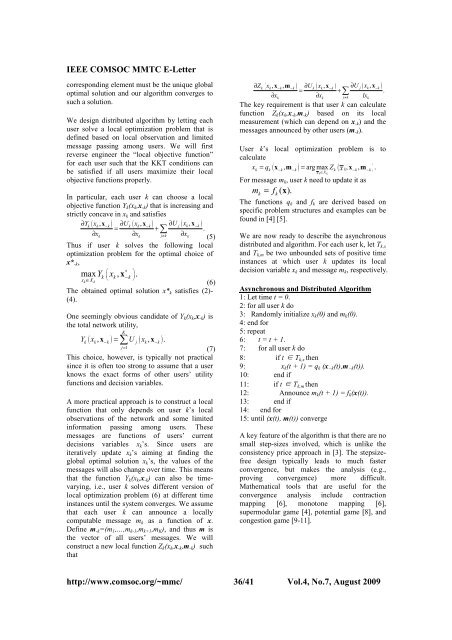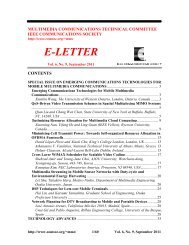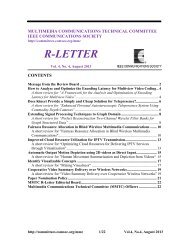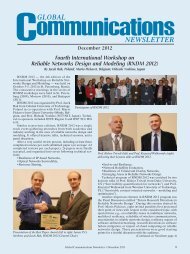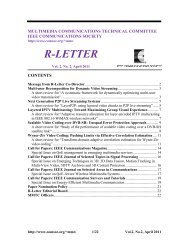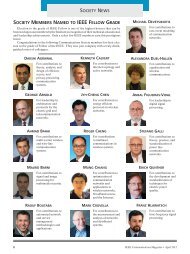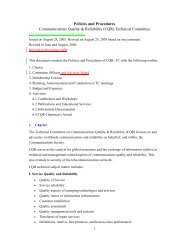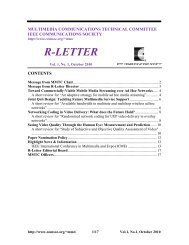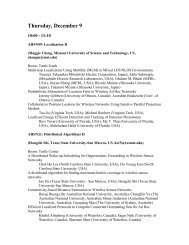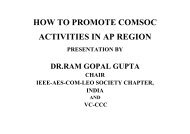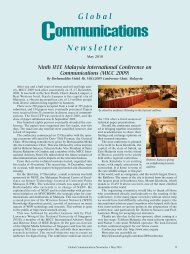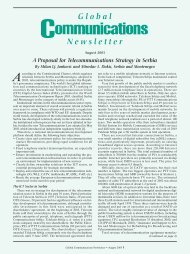E-LETTER - IEEE Communications Society
E-LETTER - IEEE Communications Society
E-LETTER - IEEE Communications Society
Create successful ePaper yourself
Turn your PDF publications into a flip-book with our unique Google optimized e-Paper software.
<strong>IEEE</strong> COMSOC MMTC E-Lettercorresponding element must be the unique globaloptimal solution and our algorithm converges tosuch a solution.We design distributed algorithm by letting eachuser solve a local optimization problem that isdefined based on local observation and limitedmessage passing among users. We will firstreverse engineer the “local objective function”for each user such that the KKT conditions canbe satisfied if all users maximize their localobjective functions properly.In particular, each user k can choose a localobjective function Y k (x k ,x -k ) that is increasing andstrictly concave in x k and satisfies∂ Yk ( xk , xk ) k ( k k ) Uj ( x−∂ U x , x ∂k, x−−k)= + ∑.∂xk ∂xk j≠k∂xk(5)Thus if user k solves the following localoptimization problem for the optimal choice ofx* -k ,⎛ ∗ ⎞maxY⎜ x , x ⎟.xk∈Xkk ⎝ k −k⎠The obtained optimal solution x* k satisfies (2)-(4).(6)One seemingly obvious candidate of Y k (x k ,x -k ) isthe total network utility,( x−) ∑ ( x−)k k k j k kj=1KY x , = U x , .(7)This choice, however, is typically not practicalsince it is often too strong to assume that a userknows the exact forms of other users’ utilityfunctions and decision variables.A more practical approach is to construct a localfunction that only depends on user k’s localobservations of the network and some limitedinformation passing among users. Thesemessages are functions of users’ currentdecisions variables x k ’s. Since users areiteratively update x k ’s aiming at finding theglobal optimal solution x k ’s, the values of themessages will also change over time. This meansthat the function Y k (x k ,x -k ) can also be timevarying,i.e., user k solves different version oflocal optimization problem (6) at different timeinstances until the system converges. We assumethat each user k can announce a locallycomputable message m k as a function of x.Define m -k =(m 1 ,…,m k-1 ,m k+1 ,m K ), and thus m isthe vector of all users’ messages. We willconstruct a new local function Z k (x k ,x -k ,m -k ) suchthat∂ Zk ( xk , xk k ) k ( k k ) Uj ( x−, m− ∂ U x , x ∂k, x−−k)= + ∑.∂xk ∂xk j≠klxkThe key requirement is that user k can calculatefunction Z k (x k ,x -k ,m -k ) based on its localmeasurement (which can depend on x -k ) and themessages announced by other users (m -k ).User k’s local optimization problem is tocalculatex = q ( x , m ) = arg max Z ( x k, x , m ).k k −k −k k −k −kx k∈XkFor message m k , user k need to update it asm = f ( x).kkThe functions q k and f k are derived based onspecific problem structures and examples can befound in [4] [5].We are now ready to describe the asynchronousdistributed and algorithm. For each user k, let T k,xand T k,m be two unbounded sets of positive timeinstances at which user k updates its localdecision variable x k and message m k , respectively.Asynchronous and Distributed Algorithm1: Let time t = 0.2: for all user k do3: Randomly initialize x k (0) and m k (0).4: end for5: repeat6: t = t + 1.7: for all user k do8: if t ∈ T k,x then9: x k (t + 1) = q k (x −k (t),m −k (t)).10: end if11: if t ∈ T k,m then12: Announce m k (t + 1) = f k (x(t)).13: end if14: end for15: until (x(t), m(t)) convergeA key feature of the algorithm is that there are nosmall step-sizes involved, which is unlike theconsistency price approach in [3]. The stepsizefreedesign typically leads to much fasterconvergence, but makes the analysis (e.g.,proving convergence) more difficult.Mathematical tools that are useful for theconvergence analysis include contractionmapping [6], monotone mapping [6],supermodular game [4], potential game [8], andcongestion game [9-11].http://www.comsoc.org/~mmc/ 36/41 Vol.4, No.7, August 2009


